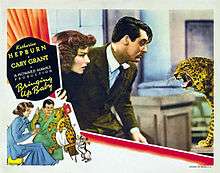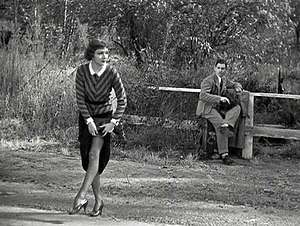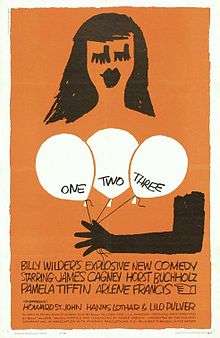Screwball comedy
Screwball comedy is a subgenre of the romantic comedy genre that became popular during the Great Depression, originating in the early 1930s and thriving until the early 1940s. It is widely known for satirizing the traditional love story. Many secondary characteristics of this genre are similar to film noir, but it distinguishes itself for being characterized by a female that dominates the relationship with the male central character, whose masculinity is challenged.[1] The two engage in a humorous battle of the sexes, which was a new theme for Hollywood and audiences at the time.[2] What sets the screwball comedy apart from the generic romantic comedy is that "screwball comedy puts its emphasis on a funny spoofing of love, while the more traditional romantic ultimately accents love."[3] Other elements of the screwball comedy include fast-paced, overlapping repartee, farcical situations, escapist themes, physical battle of the sexes, disguise and masquerade, and plot lines involving courtship and marriage.[2] Screwball comedies often depict social classes in conflict, as in It Happened One Night (1934) and My Man Godfrey (1936).[2] Some comic plays are also described as screwball comedies.

History
Screwball comedy has proved to be one of the most popular and enduring film genres. It Happened One Night (1934),[2] is often credited as the first true screwball, though Bombshell starring Jean Harlow preceded it by a year. Although many film scholars agree that its classic period had effectively ended by 1942,[4] elements of the genre have persisted or have been paid homage to in contemporary films. Still more, other film scholars argue that the screwball comedy lives on.
During the Great Depression, there was a general demand for films with a strong social class critique and hopeful, escapist-oriented themes. The screwball format arose largely as a result of the major film studios' desire to avoid censorship by the increasingly enforced Hays Code. In order to incorporate prohibited risqué elements into their plots, filmmakers resorted to handling these elements covertly. Verbal sparring between the sexes served as a stand-in for physical, sexual tension.[5] Though some film scholars, such as William K. Everson argue "screwball comedies were not so much rebelling against the Production Code as they were attacking–and ridiculing– the dull, lifeless respectability that the Code insisted on for family viewing.[6]
The screwball comedy has close links with the theatrical genre of farce,[3] and some comic plays are also described as screwball comedies. Many elements of the screwball genre can be traced back to such stage plays as Lysistrata by Aristophanes, William Shakespeare's Much Ado About Nothing, As You Like It and A Midsummer Night's Dream and Oscar Wilde's The Importance of Being Earnest. Other genres with which screwball comedy is associated include slapstick, situation comedy, romantic comedy and bedroom farce.
Characteristics

Films definitive of the genre usually feature farcical situations, a combination of slapstick with fast-paced repartee and show the struggle between economic classes. They also generally feature a self-confident and often stubborn central female protagonist and a plot involving courtship and marriage or remarriage. These traits can be seen in both It Happened One Night and My Man Godfrey (1936). The film critic Andrew Sarris has defined the screwball comedy as "a sex comedy without the sex."[7]
Like farce, screwball comedies often involve masquerade and disguise in which a character or characters resort to secrecy. Sometimes screwball comedies feature male characters cross-dressing, further contributing to elements of masquerade (Bringing Up Baby (1938) I Was a Male War Bride (1949), and Some Like It Hot (1959)). At first, the couple seem mismatched and even hostile to each other but eventually overcome their differences in an amusing or entertaining way that leads to romance. Often this mismatch comes about when the man is of a lower social class than the woman (Bringing Up Baby, Holiday, both 1938). The final romantic union is often planned by the woman from the outset, and the man is seemingly oblivious to this. In Bringing Up Baby, the woman says to a third party: "He's the man I'm going to marry. He doesn't know it, but I am."

These pictures also offered a kind of cultural escape valve: a safe battleground on which to explore serious issues such as class under a comedic and non-threatening framework.[8] Class issues are a strong component of screwball comedies: the upper class are represented as idle, pampered, and having difficulty coping with the real world. By contrast, when lower-class people attempt to pass themselves off as upper-class or otherwise insinuate themselves into high society, they are able to do so with relative ease (The Lady Eve, 1941; My Man Godfrey, 1936). Some critics believe that the portrayal of the upper class in It Happened One Night was brought about by the Great Depression, and the financially struggling moviegoing public's desire to see the rich upper class taught a lesson in humanity.
Another common element of the screwball comedy is fast-talking, witty repartee (You Can't Take It with You (1937) and His Girl Friday (1940)). This stylistic device did not originate in the genre (although it may be argued to have reached its zenith there): it is also found in many of the old Hollywood cycles, including gangster films and romantic comedies.
Screwball comedies also tend to contain ridiculous, farcical situations, such as in Bringing Up Baby, where a couple must take care of a pet leopard during much of the film. Slapstick elements are also frequently present, such as the numerous pratfalls Henry Fonda takes in The Lady Eve (1941).
One subgenre of screwball is known as the comedy of remarriage, in which characters divorce and then remarry one another (The Awful Truth (1937), The Philadelphia Story (1940)). Some scholars point to this frequent device as evidence of the shift in the American moral code, as it showed freer attitudes toward divorce (though the divorce always turns out to have been a mistake).
Another subgenre of screwball comedy has the woman chasing a man who is oblivious to or not interested in her. Examples include Barbara Stanwyck chasing Henry Fonda (The Lady Eve (1941), Marion Davies chasing Antonio Moreno (The Cardboard Lover (1928), Marion Davies chasing Bing Crosby (Going Hollywood (1933), and Carole Lombard chasing William Powell (My Man Godfrey (1936).
The philosopher Stanley Cavell has noted that many classic screwball comedies turn on an interlude in the state of Connecticut (Bringing Up Baby, The Lady Eve, The Awful Truth).[9] In Christmas in Connecticut (1945), the action moves to Connecticut and remains there for the duration of the film.
Notable examples from the genre's classic period

- The Patsy (1928), directed by King Vidor, starring Marion Davies, Marie Dressler, and Lawrence Gray
- The Front Page[10] (1931) (remade as His Girl Friday), directed by Lewis Milestone, starring Adolphe Menjou and Pat O'Brien
- It Happened One Night[11][12] (1934), directed by Frank Capra, starring Clark Gable and Claudette Colbert
- Twentieth Century[10][12] (1934), directed by Howard Hawks, starring John Barrymore and Carole Lombard
- My Man Godfrey[11] (1936), directed by Gregory La Cava, starring William Powell and Carole Lombard
- Cain and Mabel (1936), directed by Lloyd Bacon, starring Marion Davies and Clark Gable
- Libeled Lady (1936), directed by Jack Conway, starring Jean Harlow, William Powell, Myrna Loy, and Spencer Tracy
- The Awful Truth[11][12] (1937), directed by Leo McCarey, starring Irene Dunne and Cary Grant
- Nothing Sacred[11] (1937), directed by William A. Wellman, starring Carole Lombard and Fredric March
- Bringing Up Baby[11] (1938), directed by Howard Hawks, starring Katharine Hepburn and Cary Grant
- His Girl Friday[11][12] (1940), directed by Howard Hawks, starring Cary Grant and Rosalind Russell
- My Favorite Wife (1940), directed by Garson Kanin, starring Cary Grant and Irene Dunne
- Mr. and Mrs. Smith (1941), directed by Alfred Hitchcock, starring Robert Montgomery and Carole Lombard
- The Lady Eve[11][12] (1941), directed by Preston Sturges, starring Barbara Stanwyck and Henry Fonda
- Ball of Fire[13][14] (1941), directed by Howard Hawks, starring Barbara Stanwyck and Gary Cooper
- The Palm Beach Story[11] (1942), directed by Preston Sturges, starring Claudette Colbert and Joel McCrea
- The More the Merrier (1943), directed by George Stevens, starring Jean Arthur and Joel McCrea.
Other films from this period in other genres incorporate elements of the screwball comedy. For example, Alfred Hitchcock's thriller The 39 Steps (1935) features the gimmick of a young couple who find themselves handcuffed together and who eventually, almost in spite of themselves, fall in love with one another, and Woody Van Dyke's detective comedy The Thin Man (1934), which portrays a witty, urbane couple who trade barbs as they solve mysteries together. Many of the Fred Astaire and Ginger Rogers musicals of the 1930s also feature screwball comedy plots, notably The Gay Divorcee (1934) and Top Hat (1935). The Eddie Cantor musicals Whoopee! (1930) and Roman Scandals (1933), and slapstick road movies such as Six of a Kind (1934) include screwball elements. Some of the Joe E. Brown comedies also fall into this category, particularly Broadminded (1931) and Earthworm Tractors (1936).
Actors and actresses frequently featured in or associated with screwball comedy include:
- Jean Arthur
- Ralph Bellamy
- Charles Coburn
- Claudette Colbert
- Gary Cooper
- Marion Davies
- William Demarest
- Melvyn Douglas
- Irene Dunne
- Clark Gable
- Cary Grant
- Jean Harlow
- Katharine Hepburn
- Edward Everett Horton
- Carole Lombard
- Myrna Loy
- Fred MacMurray
- Ray Milland
- William Powell
- Ginger Rogers
- Rosalind Russell
- Barbara Stanwyck
- James Stewart
Some notable directors of screwball comedies include:
Later screwball comedies


Various later films are considered by some critics to have revived elements of the classic era screwball comedies, including:
- Champagne for Caesar (1950), d. Richard Whorf
- The Mating Season (1951), d. Mitchell Leisen
- Monkey Business (1952), d. Howard Hawks
- How to Marry a Millionaire (1953), d. Jean Negulesco
- The Seven Year Itch (1955), d. Billy Wilder
- Bell, Book and Candle (1958), d. Richard Quine
- Pillow Talk (1959), d. Michael Gordon
- Some Like It Hot (1959), d. Billy Wilder
- The Grass Is Greener (1960), d. Stanley Donen
- Lover Come Back (1961), d. Delbert Mann
- One, Two, Three (1961), d. Billy Wilder
- It's a Mad, Mad, Mad, Mad World (1963), d. Stanley Kramer
- Man's Favorite Sport? (1964), d. Howard Hawks
- Send Me No Flowers (1964), d. Norman Jewison
- A Funny Thing Happened on the Way to the Forum (1966) d. Richard Lester
- Walk, Don't Run (1966), d. Charles Walters
- What's Up, Doc? (1972), d. Peter Bogdanovich
- For Pete's Sake (1974), d. Peter Yates
- Heaven Can Wait (1978), d. Warren Beatty and Buck Henry
- Something Wild (1986), d. Jonathan Demme
- Overboard (1987), d. Garry Marshall
- Raising Arizona (1987), d. Coen Brothers
- Women on the Verge of a Nervous Breakdown (1988), d. Pedro Almodóvar
- Oscar (1991) d. John Landis[15]
- Sólo con Tu Pareja (1991), d. Alfonso Cuarón
- The Hudsucker Proxy (1994), d. Joel Coen
- Flirting With Disaster (1996), d. David O. Russell
- Little Nicky (2000), d. Steven Brill
- Rat Race (2001), d. Jerry Zucker
- Intolerable Cruelty (2003), d. Coen Brothers
- Miss Pettigrew Lives for a Day (2008), d. Bharat Nalluri
- Our Idiot Brother (2011), d. Jesse Peretz
- While We're Young (2014), d. Noah Baumbach
- Mistress America (2015), d. Noah Baumbach
- She's Funny That Way (2015), d. Peter Bogdanovich
- Hail, Caesar! (2016), d. Coen Brothers
- Chongqing Hot Pot (2016), d. Yang Qing[16]
Elements of classic screwball comedy often found in more recent films which might otherwise simply be classified as romantic comedies include the "battle of the sexes" (Down with Love, How to Lose a Guy in 10 Days), witty repartee (Down with Love), and the contrast between the wealthy and the middle class (You've Got Mail, Two Weeks Notice). Many of Elvis Presley's films from the 1960s had drawn, consciously or unconsciously, the many characteristics of the screwball comedy genre. Some examples are Double Trouble, Tickle Me, Girl Happy and Live A Little, Love A Little. Modern updates on screwball comedy also sometimes are categorized as black comedy (Intolerable Cruelty, which also features a twist on the classic screwball element of divorce and remarriage). The Coen Brothers often include screwball elements in a film which may not otherwise be considered screwball or even a comedy.
The Golmaal movies, a series of Hindi-language Indian films, have been described as a screwball comedy franchise.[17][18]
Screwball comedy elements in other genres
In his 2008 production of the classic Beaumarchais comedy The Marriage of Figaro, author William James Royce trimmed the five-act play down to three acts and labeled it a "classic screwball comedy". The playwright made Suzanne the central character, endowing her with all the feisty comedic strengths of her classic film counterparts. In his adaptation, entitled One Mad Day! (a play on Beaumarchais' original French title) Royce underscored all of the elements of the classic screwball comedy, suggesting that Beaumarchais may have had a hand in the origins of the genre.
The television series Moonlighting (1985–1989), Married... with Children (1987–1997), NewsRadio (1995–1999), Gilmore Girls (2000–2007), The O.C. (2003–2007), Standoff (2006–2007), and Gossip Girl (2007–2012) have also adapted elements of the screwball comedy genre for the small screen.
The second part of the 1978 film Superman, set in fictional Metropolis, takes on a screwball tone after the seriousness of the original story.
The Adventures of Tintin comic The Castafiore Emerald contains settings, plots, comic devices, and character types that share many similarities to screwball comedies.
The plot of Corrupting Dr. Nice, a science fiction novel by John Kessel involving time travel, is modeled on films such as The Lady Eve and Bringing Up Baby.[19]
See also
References
-
Dancyger, Ken; Rush, Jeff (2006). Alternative Scriptwriting (Fourth ed.). Focal Press. pp. 85–85. ISBN 978-0240808499.
The screwball comedy is funny film noir that has a happy ending... The premise of the film is about the struggle in their relationship. During the course of the struggle, which is highly sexually charged, the maleness of the central character is challenged. The female is the dominant character in the relationship. This role reversion is central to the screwball comedy.
- Cele Otnes; Elizabeth Hafkin PleckCele Otnes, Elizabeth Hafkin Pleck (2003) Cinderella dreams: the allure of the lavish wedding University of California Press, p. 168 ISBN 0-520-24008-1
- Gehring, Wes D. (2008). Romantic vs. Screwball Comedy: Charting the Difference. Lanham: Scarecrow Press Inc. p. 186.
-
Byrge, Duane; Miller, Robert Milton (1991). The Screwball Comedy Films: A History and Filmography, 1934–1942. McFarland. p. 104. ISBN 978-0-89950-539-8.
With the explosive exception of His Girl Friday, screwball comedy had calmed considerably by 1940 from its peak of zaniness in 1937-38.
- "Under the Radar: The Hays Code and the Birth of Screwball". virginia.edu. University of Virginia. Retrieved 21 March 2018.
- Everson, William K. (1994). Hollywood Bedlam: Classic Screwball Comedies. New York: Carol Publishing Group.
- Citation Sarris, Andrew. You Ain’t Heard Nothin’ Yet: The American Talking Film, History & Memory, 1927–1949, Oxford University Press, New York, 1998
- The Screwball and Its Audience - University of Virginia
- Cavell, Stanley. Pursuits of Happiness: The Hollywood Comedy of Remarriage. Cambridge, Massachusetts: Harvard University Press, 1981
- Tim Dirks. "Comedy films: Screwball comedy". filmsite.org.
- "10 great screwball comedy films". British Film Institute.
- Robbie Collin (23 June 2015). "Who killed the screwball comedy?". The Telegraph.
- WILSON, BY JAKE (2011-02-25). "The lost art of screwball comedy". The Sydney Morning Herald. Retrieved 2019-01-01.
- Gemmill, Allie. "These 21 Underrated Rom-Coms Should Be Next In Your Netflix Queue". Bustle. Retrieved 2019-01-01.
- "Stallone`s `Oscar` Recovers From Bad Start". chicagotribune.com. Retrieved 21 March 2018.
- Marsh, James (March 23, 2016). "'Chongqing Hot Pot': HKIFF review". Screen Daily. Retrieved March 28, 2016.
- "Golmaal Again Movie Review Meena Iyer".
- "blends perfectly with the screwball flavour of Golmaal".
- Gevers, Nick (16 October 1999). "Corrupting Dr Nice by John Kessel". infinity plus. Retrieved 29 August 2012.
Further reading
- Screwball Comedy: Defining a Film Genre, Wes D. Gehring, 1983.
External links
- Screwball Comedy Primer - Green Cine
- Home of the Screwball - University of Virginia
- Screwball Comedy - film reference
- Screwball Comedy - Everything2
- Screwball Comedy Film: Definition - wordiQ
- Great Directors: Mitchell Leisen - Senses of Cinema
- Head Over Heels - The Guardian
- (in French) La Screwball Comedy - CINEMACLASSIC
- (in German) Screwball Comedies: Ein enzyklopädischer Artikel - University of Hamburg